Do you have lungs? Would you like to keep them? Good. (You and me both!)
Air is the one thing you can’t live without, and airborne pollutants are the ones you usually can’t see. So let’s chat about the indoor air quality of your camper.
I have good news and bad news.
The bad news is that RV indoor air quality is usually mediocre, there are no enforced codes or universal testing standards, very little OEM innovation, and DIY solutions are time-consuming.
The good news is I saved 15% or more on my car insurance.
>> This is Part 3: How to Air Out Those Chemical VOCs!
Mugshots: Meet the Enemies of Clean Air
Now, we all want clean, pure, fresh air in our RVs and campers! Unfortunately, we wage war against three enemies:
We’ll talk more about these in greater depth in Parts 2, 3, and 4 of this series on RV indoor air quality.
Volatile Organic Compounds
What Is a VOC?
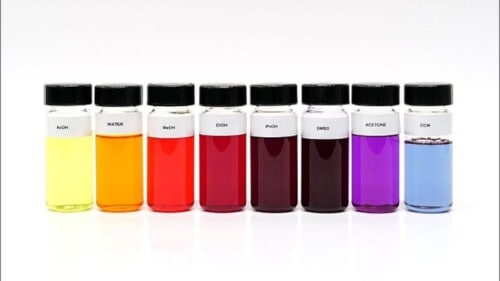
Basically, some materials release airborne chemicals that, in sufficient concentration, can harm our health.
Many of these airborne chemicals are called VOCs: Volatile Organic Chemicals.
I’m a mechanical engineer, not a chemical scientist. So I won’t try to explain the ins and outs of phthalates versus phenols.
VOCs are a family of chemical compounds numbering in the tens of thousands. Many are organic solvents found in everyday materials: flooring, wood finishes, moth repellents, printer ink and permanent markers.
These VOCs are released into the air through off-gassing.
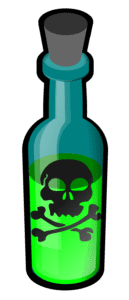
In other words, certain chemicals and compounds become inhalants. You breathe them in, and (hopefully) you breathe them out.
That new car smell in your latest Subaru? Well, it’s actually a vaporous stew of VOCs emitted mostly by your faux leather upholstery, low-pile carpet flooring, nonwoven headliner, soft-touch black dashboard, and hard buttons and switches – which are all plastics!
That’s something worth remembering. Many, maybe even most, sources of VOCs are some type of plastic.
The Environmental Protection Agency (EPA) has long recognized that many Volatile Organic Compounds (VOCs) can pose a significant threat to indoor air quality. Many are known or suspected carcinogens.
Are All VOCs Dangerous to My Health?
But before we go any further, let’s not get blinded by fear. Tens of thousands of chemicals are technically VOCs, and not all VOCs are evil!
For instance, most fruits produce ethylene gas, which helps ripen (and decay) neighboring fruits and vegetables. That’s why bananas turn brown when left in the grocery bag.
Ever enjoy the scent of sagebrush or wintergreen? Thank a VOC for that!
So don’t freak out every time you see the word “VOC.”
With that said, many VOCs are undeniably harmful and incredibly dangerous. I’ve used my fair share of industrial solvents and cleaners, like MEK and xylene. These solvents can cause permanent brain damage!
But when we’re talking about VOCs in RVs, we’re not usually talking about perfumes or industrial-strength solvents.
We’re talking about low-level VOC emissions from common building materials like vinyl flooring, wallpaper, and wood finishes.
VOCs are all around us. But they tend to pile up in RVs and campers for four reasons.
Why Do RVs Have Poor Indoor Air Quality?
Lots of Stuff, Small Space
1 RV designers pack a lot in a small space! We put a kitchen, shower, dinette and bedroom in what some people would consider a walk-in closet.
There’s not much air to share. So the concentration of VOCs is bound to be higher.
Not Much Air Exchange
2 There’s no air exchange or passive ventilation requirements for an RV camper. In fact, manufacturers generally try to build RVs as airtight as possible for better insulation.
So unless you open a window or turn on a fan, there’s no meaningful airflow within a camper. That means VOCs can accumulate during storage if an RV is not vented.
High Storage Temperature
3 Off-gassing increases with temperature. And whereas the interior temperature of your home may never exceed 80 deg, an RV interior commonly reaches 90, 100 even 120 degrees! It’s like an oven for VOCs!
Choice of Building Materials
4 Let’s take a look at three common categories of building materials used in RV construction.
> Manufactured Wood Goods
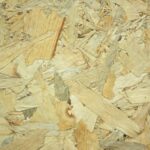
Pop Quiz: What do all these materials have in common?
- Particleboard
- Oriented-Strand Board (OSB)
- Medium-Density Fiberboard (MDF)
- Melamine
- Laminates
Answer: Formaldehyde!
Types include urea formaldehyde, phenol formaldehyde, and melamine formaldehyde. These sheet goods are used in”
- Vinyl-wrapped furniture
- Plywood seat covers
- Solid OSB subfloors
- Counter- and table-tops
- Lauan plywood wall and ceiling panels
- Plank flooring
If that sounds like almost everywhere … then yes, it is almost everywhere.
Formaldehyde emissions remains a big concern for many new RVs.
Thankfully, regulations have tightened up quite a bit since Hurricane Katrina. Today, many of the decorative plywood, particleboard and MDF products sold in the US are either no-added formaldehyde (NAF) or ultra low-emitting formaldehyde (ULEF) products. Whew! Breathe easy!
However, please note that structural panels, like subflooring OSB and exterior-grade plywood, are exempt from these regulations.
Now, some will argue that these panels use low-emitting adhesives anyways, so that’s no biggie. However, in the cramped and unventilated interior of an RV, even small formaldehyde emissions can quickly add up.
> Engineering Plastics
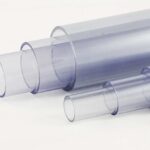
PVC is a plastic workaholic. It can do anything! Unfortunately, it’s also known as “the poison plastic.” It has been banned in many countries. You might find it in:
- Drain piping
- Vinyl upholstery
- Wallpaper
- Plank flooring
- Sheet flooring
- Countertops and tables
ABS is a common plastic for thermoforming, often found in:
- Shower pan
- Shower enclosure
- Bathroom sinks
- Plastic storage cubbies
- Exterior body trim
Some other common plastics include:
- PP (polypropylene): Carpet backing. It can release 4-PC, which is an eye- and respiratory-irritant.
- PU (polyurethane): Foam mattresses*, mattress toppers, spray foam
- PS (polystyrene): Laminated wall block foam, composite panels
*Foam mattresses, along with other upholstery items, can also release brominated flame retardants.
Unfortunately, most plastics are bad for you or the environment in some way, whether in manufacturing, use, or disposal. However, they don’t off-gas formaldehyde, and VOC emissions quickly taper off after production.
> Solvents and Adhesives

Almost every adhesive, solvent, sealant, paint or coating used inside or outside your RV will release VOCs.
That is by their nature. In order for a liquid caulk to dry, the solvent or carrier must evaporate. And even water-based caulks and sealants usually have toxic solvent components.
It’s a pretty long list. That caulk around your counter? The clear finish on your cabinets? Your sheet vinyl flooring adhesive? Your exterior trim sealant?
Almost all caulks, paints and sealants release VOCs, I’m afraid. If you want to know exactly what’s in your caulk, find the MSDS sheet. You’ll see that many of them won’t allow storage or use in unventilated spaces, and virtually none of them are approved for skin- or eye-contact.
Is There Any Hope for Eliminating VOCs?
At this point, you’re probably looking around your RV and wondering, “Is there ANYTHING in here that isn’t TRYING TO KILL ME?!”
I have some good news.
1) Skin Deep Is All That Matters!
When it comes to off-gassing, we mostly only care about what’s skin deep.
For instance, your RV walls are probably a sandwich of gel-coated fiberglass, Azdel, expanded polystyrene foam, luan plywood and wallpaper.
We care mostly about the plywood and wallpaper. Everything else is buried and will have less impact on interior air quality.
2) VOC Emissions Drop with Time
You might have heard that laminate flooring off-gasses for 10 years. Well, technically, it off-gasses forever. But after 10 years, the amount is negligible.
Even better, the majority of the off-gassing occurs in the first few weeks and months!
It’s impossible to say just how much and how fast a material will off-gas. This varies based on temperature, humidity, and a dozen other factors.
But as a rule, off-gassing follows the rule of exponential decay.
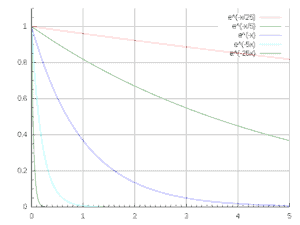
So VOC emissions fall off a cliff with age. They start as a waterfall, but the rate quickly slows to a trickle.
By the time you pick up your RV, all your parts will be at least several weeks and probably months (maybe even years!) old. Most of the work is done!
3) You Can Choose Non-Emitting Products
Yes! There are actually non-emitting products!
You can see a list of non-emitting and low-emitting materials here.
Here are some common zero-VOC materials.
- Salvaged and reused architectural millwork
- Stone and masonry
- Powder-coated metals
- Anodized aluminum
- Glass
- Concrete
- Untreated solid wood
Most of these materials are heavy and are rarely installed in an RV travel trailer or motorhome. However, if you’re renovating your RV, do what you want!
How to Get Rid of VOCs in Your RV
Air It Out
Isn’t it wonderful when the best solution is also the cheapest? Simply open a window, turn on the fans, and let Mother Nature work her magic.
This is the simplest, easiest, cheapest and best way to improve your RV air quality.
Don’t forget to open up the cabinets as well! You want all the air to get flushed out!
Or Cook It Out
VOC emissions increase with heat. So if you crank up the heat in your RV, more VOCs will be released into the air!
- Park your RV in direct sunlight and close all the windows, fans and doors.
- Or close all windows and doors and turn your furnace on high.
- Let the interior reach at least 90 degrees, and let it side for 12-24 hours.
- Obviously, please don’t use the camper during this time!
- Open up all the windows and doors and turn on the fan! ‘Cause boy, it’ll stink! Let it air out for at least 3-4 hours.
- Repeat this process as necessary.
- Do NOT use the camper unless you’ve vented it out for at least 3-4 hours AND allowed it to sit overnight!
P.S. There is another version of “cook it out” that involves high heat and evaporation of liquid ammonia. I do NOT recommend this method for most people. Ammonia is highly corrosive and in sufficient concentrations can cause immediate burning of the eyes and lung damage.
>> READ MORE: Are There Any Chemically-Safe RVs?
Or Seal It In!
Whereas cooking it out tries to eliminate all residual formaldehyde, this method seals it all in! Since VOCs are released with exposure to air, this solution is to cover the offending material with an air-tight barrier.
Some people try to use aluminized foil or some other sheet product, but this is impractical for larger campers and RVs. A liquid-applied coating is much easier.
Many people swear by shellac. This incredible wood finish is one of the oldest natural finishes in the world. It’s made from the secretions of the India lac bug. Shellac makes anything shine! It’s almost darn-near vapor-proof. Two solid coats of shellac will seal most vapors from the substrate.
Zinsser is by far the biggest importer of shellac in the U.S. You can purchase their shellac products by the gallon.*
*Fair warning: In liquid form, the shellac is dissolved in alcohol, which does emit VOCs of its own. So find a friend to help you out, and wear a mask.
A shellac alternative is AFM SafeCoat Hardseal, a clear ultra-low VOC sealer. AFM SafeCoat Hardseal is more durable than shellac, but it cannot be applied over particleboard. Meanwhile, as the saying goes, “Shellac sticks to everything, and everything sticks to shellac.”
Neither of these two finishes are rated for heavy-traffic surfaces like floors, countertops, etc. For that, you’ll need to move on to the next idea!
Personally, I have found that Green Building Supply is an excellent source for these and many similar materials.
Renovate Your Camper Interior
What you can’t seal in or cook out, you can replace. Obviously, you can’t replace all offending materials – but remember, it’s what’s skin-deep that matters most.
Public Enemy No. 1 is probably your carpet or vinyl flooring. If you can’t cover it up, rip it out. Replace it with genuine linoleum sheet flooring or unfinished wood, like Douglas Fir, Teak or Oak. Take a look at the earlier list of non-emitting materials, too.
If you own a motorhome, you might be able to get away with porcelain tile flooring. Everyone else, stay away! – it’ll crack!
Public Enemy No. 2 might be your mattress and furniture. The polyurethane foam used in most cheap mattresses is a veritable greenhouse for VOCs. You can do better!
If you do choose a foam mattress or mattress topper, purchase one that is GreenGuard Gold certified or CertiPUR-Us certified. Look into green alternatives. There are plentiful options!
- Natural latex mattresses
- All-cotton shikibutons
- Wool- or plant fiber-stuffed spring steel mattresses
Research RV Brand Build Quality
Which is the RV with best indoor air quality?
Now, let me set something straight. RV manufacturers are really best described as “assemblers.” Most components, like refrigerators, furnaces, beds, etc., are all purchased from vendors.
So it’s not like we directly control formaldehyde levels. We use more-or-less the same construction plywood everyone else does.*
And, in case you didn’t already know, most of the RV market is controlled by two companies: Thor Industries and Forest River (owned by Berkshire Hathaway). Forest River produces more than 20 RV brands alone!
The supply chain is similarly monopolized. A handful of companies, such as Dometic and Lippert, own most of the market.
So the bad news is that most RVs are pretty much the same. You’ll need to look at A) smaller, independent manufacturers or B) luxury RVs to find any with low VOC emissions.
If you are more sensitive to formaldehyde, then you may benefit from an aluminum-framed or aluminum-skinned camper.
Of these, the king is arguably Airstream. As of 2021, no wood is used in the construction of the shells.
Smaller boutique manufacturers like InTech may use aluminum-framed structures. ATC builds all-aluminum toy haulers. There are a handful of other all-aluminum campers as well.
Other premium brands, like Little Guy or NuCamp, substitute poplar plywood and hardwood for vinyl-wrapped particle board.
Pay for a Custom RV Build
Whew! This is drastic. And expensive. Expect to pay roughly 3x as much for a custom chemical-safe RV compared to a similar model on a dealer lot.
A skilled private builder can design and fabricate a low-VOC, formaldehyde-free, chemically-safe camper.
Rather than using particleboard, the builder might use PureBond plywood, which is made with a formaldehyde-free adhesive.
- Shell could be aluminum-framed and skinned.
- Countertops might be oiled and waxed butcher block, solid maple.
- Paint could be ultra-low VOC acrylic latex.
For every VOC offender, there is normally a low-VOC replacement – but as I said, expect to sell your body for indentured servitude in order to pay for it. You need expensive materials and extremely skilled labor to pull this off.
Purchase a Used Camper
Purchasing a used RV is a double-edged sword.
I’m not suggesting your purchase Ol’ Bertha, your neighbor’s 38-ft travel trailer with dry-rotted tires and a blue strap bungee strapped across the roof to keep out the rain.
That’s a recipe for disaster. Many, if not most, older RVs have experienced a leak or two. Many have hidden mold or mildew spots, especially around windows and inside ceilings.
Instead, I’m suggesting you purchase a well-kept unit, one used at least every few months, preferably from the desert Southwest.
You see, purchasing a used RV has three major benefits:
- Most of the off-gassing is complete! After 5-10 years, off-gassing from many materials is negligible.
- If you purchase a well-kept camper from an arid climate, then there’s a low chance of mold!
- Someone else has already debugged the camper. Now, you get to enjoy it.
- Bonus: You can snag a great deal!
If you’re shopping used, check out the all-aluminum CampLite or LivinLite trailers.
Leave a Reply